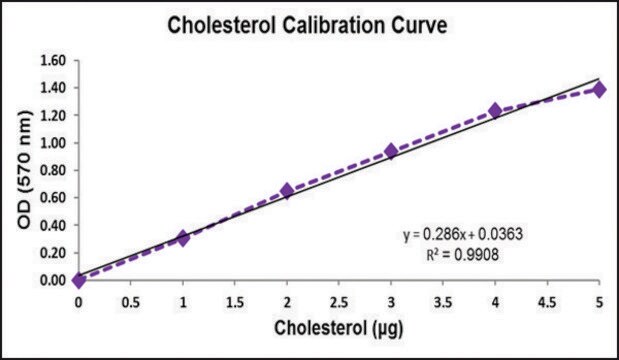CS0001
Phospholipid quantification Assay Kit (Colorimetric/Fluorometric)
sufficient for 200 colorimetric or fluorometric tests
Synonym(s):
DDPC, DEPC, DLOPC, DLPC, DMPC, DOPC, DPPC, DSPC, EPC, HEPC, HSPC, LYSOPC, MPPC, MSPC, PC, PMPC, POPC, PSPC, Phosphatidylcholine, SMPC, SOPC, lecithin, lysolecithin, sphingomyelin
About This Item
Recommended Products
usage
sufficient for 200 colorimetric or fluorometric tests
shipped in
dry ice
storage temp.
−20°C
General description
The Phospholipid quantification assay kit provides a simple and highly sensitive method for measuring choline-containing phospholipids in biological samples. This high-throughput assay can be done within only 30 minutes . In this assay, phospholipids (such as lecithin, lysolecithin, and sphingomyelin) are enzymatically hydrolyzed to release choline, which is determined using choline oxidase and an H2O2 specific dye. The readout is either fluorescence or absorbance, allowing maximal flexibility and a large detection range. The linear range is 0.1-0.5 nmol (fluorescence) and 1 to 5 nmol (absorbance). Phosphatidylcholine-containing phospholipids are present in serum at ~0.2-2.5 mM (~50-200 mg/dL).
The detection range of the kit is 0.1-0.5 nmol (fluorescence) and 1 to 5 nmol (absorbance).
Application
- Measuring choline-containing phospholipids in biological samples (For example: Serum and Plasma)
- Enables evaluation of drug effects on phospholipids metabolism
Features and Benefits
- Highly sensitive, simple and high-throughput assay for measuring choline-containing phospholipids in biological samples
- User friendly: No need to weigh or calculate needed amounts of reagents on your own
- Supportive calculator (Click here to download a calculator excel file):will calculate the reagents needed according to your experimental needs, and analyses your results based on your experimental data!
- Quick instruction bench card - to assure your experimental success
- More experiments in one kit - contains sufficient reagents for 200 tests.
- Suitable for both colorimetric and fluorometric detection
- Detection time: only 30 minutes
Suitability
signalword
Danger
hcodes
Hazard Classifications
Aquatic Chronic 3 - Eye Irrit. 2 - Flam. Liq. 2 - Resp. Sens. 1 - Skin Sens. 1
Storage Class
3 - Flammable liquids
flash_point_f
No data available
flash_point_c
No data available
Choose from one of the most recent versions:
Certificates of Analysis (COA)
Don't see the Right Version?
If you require a particular version, you can look up a specific certificate by the Lot or Batch number.
Already Own This Product?
Find documentation for the products that you have recently purchased in the Document Library.
Customers Also Viewed
Our team of scientists has experience in all areas of research including Life Science, Material Science, Chemical Synthesis, Chromatography, Analytical and many others.
Contact Technical Service









